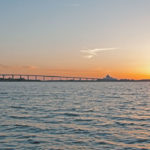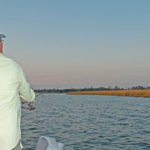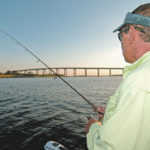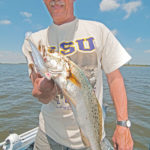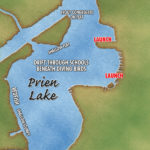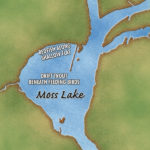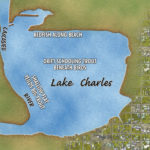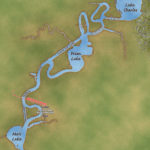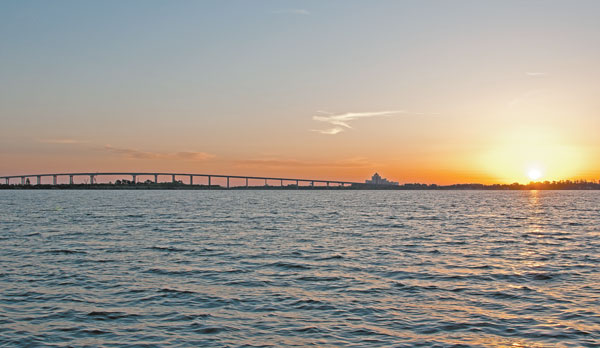
Calcasieu’s 3 other lakes offer strong speckled trout action
Gary Medicis and wife Amelia launched at Prien Lake Park with trout on their minds. The fishing had been pretty easy lately, with birds telling them exactly where specks were feeding on the multitude of bait.
And the water on Prien Lake was just beautiful at the landing as the sun began pushing back the darkness.
Even more exciting was what the Medicises saw less than 100 yards away. “
The birds were diving right where the no-wake buoys are,” Gary Medicis said.
The couple was pumped, but Gary Medicis didn’t start the main motor and run to the school. Instead, he simply trolled closer, and the husband-and-wife team cast lures into the middle of the school of bait.
It didn’t take long.
“We never started the outboard that day,” Medicis reminisced. “We caught our limit of trout without ever having to run.”
It’s that kind of fishing that has prompted this angler to pretty much give up running the 13 miles down the Calcasieu River to the better known and more-famous Big Lake.
“I fish (Prien) a lot, and the reason I like it is because I don’t have to go far,” Medicis said. “There are trout and redfish here all year long.
“One of the biggest redfish I’ve ever caught was right in front of Will Drost’s house (on Prien).”
Prien Lake is decidedly smaller than its bigger brother south of Lake Charles, measuring just over 1½ miles long by a maximum of 1.2 miles wide. But that petite size doesn’t bother Medicis.
“It doesn’t get much pressure,” he said of Prien. “And I catch plenty of fish here.”
And, while Big Lake might have the reputation for holding huge specks, Medicis said the Prien Lake fish he packs in his freezer aren’t guppies.
“Don’t get me wrong: I know Big Lake, and you can catch some big fish down there,” he said. “But you can catch just as many big fish up here.”
And the average trout is solid.
“I catch a lot of 2- to 4-pound trout up here,” Medicis said.
But if the fishing isn’t on in Prien, there are still options that don’t include joining the Big Lake crowds.
“There are so many areas to fish,” Medicis said. “You’ve got the lake of Lake Charles, you’ve got the (Calcasieu River) ship channel, you’ve got Prien Lake and a lot people go down to Moss Lake.”
As with Prien, Lake Charles and Moss Lake are pretty small. But they hold reds and trout throughout the year — and all three diminutive lakes are located along a 10½-mile stretch of the Calcasieu River, making them perfect for small-boat anglers like Medicis.
“I used to have a big bay boat,” he said. “But I sold it.”
Now he makes regular trips with a small bateau with a bored-out 25-horse Tohatsu.
“In all reality, you don’t need a bay boat,” Medicis said.
In fact, bay boats can be a handicap, he said.
Take, for instance, the marshes north of the Haymark terminal just north of Moss Lake. Medicis catches a lot of reds along the banks of Gray Plantation Golf Course, and then he can drift the open water for trout there.
But it’s skinny business.
“The guys with big bay boats can’t get in there,” he said. “They might be able to run in, but they’re going to have problems when they come off plane.”
Medicis prefers a rising tide because most of the water he fishes is relatively shallow: The deepest part of Prien measures only about 9 feet.
“It brings in clean water,” he said.
His main strategy throughout the summer and fall is to let flocks of birds mark schools of feeding fish.
That action just builds to a peak by the fall.
“In the fall of the year, there will be four or five sets of birds working Prien,” Medicis said. “It’s just unreal.
“In the fall, if you can’t catch fish in here, you just don’t know how to fish.”
Running the birds produces boxes of trout, but it also is a great way to fill out redfish limits.
“A lot of times you’ll catch a trout, trout, trout and then a redfish,” Medicis said. “They’ll be mixed in with the trout. It doesn’t take long like that.”
He’s pretty simple in his lures: He tosses artificial baits, sticking with the standards of Cocahoes, spinners and spoons, into the schools, and quickly fills out limits. He also will throw a topwater, at times.
One of his favorites for schooling trout is a silver Mr. Champ spoon.
“Trout won’t bite a gold spoon, but they will eat that silver spoon,” Medicis said.
And schooling trout aren’t just found in the lakes along the river: The ship channel itself will fill with fish.
“What happens a lot of times is that fish will be in the lakes early in the day, but when it starts getting hot, they’ll move to the ship channel,” Medicis said.
One especially productive area is the stretch between Coon Island and Bayou Contraband, but fish will prowl the banks all the way past Clooney Island.
“They’ll school all the way to the lake of Lake Charles,” he said.
Of course, there are times when he has to resort to bouncing plastics on the bottom.
For trout, that means any kind of Cocahoe or grub he has in his bag. He generally sticks with ¼-ounce jigheads.
That’s usually enough to put some hefty trout in the boat, along with flounder.
When he’s targeting redfish throughout the system, he usually starts with spinners. But when that fails, he has a fallback.
“Gulp shrimp is my secret weapon,” Medicis said. “I like the new penny and root beer colors.”
He will fish this stink bait under a cork, and he said the bait rarely fails to produce hard-hitting bites.
So why not fish with Gulp even when targeting trout? First, he usually doesn’t have to, but there’s another reason.
“When it comes to specks I don’t get bites on (Gulp),” Medicis said. “I don’t know why, but I just don’t.”
And, no matter what happens, there are few times he blanks when fishing the minor Calcasieu River lakes.
“I’ve only zeroed once or twice,” Medicis said. “I pretty much always catch fish.”
Prien Lake
Prien Lake is fairly flat and really all looks about the same, but Medicis said there are a couple of hotspots for trout.
Outside of chasing down birds, one of the most-popular and consistent areas is just south of the Interstate 210 bridge on the east side of the little island separating the northern end of the lake and the Calcasieu Ship Channel.
“It’s a flat out there, and it sort of drops off into a trough,” Medicis said. “The fish just move back and forth along that trough.”
There is a reason why the trout love this area.
“It’s sort of grassy, and the shrimp hide in there,” he explained.
The flat extends under I-210 to the northern point where the lake meets the ship channel, and Medicis said there are plenty of fish available there when the gulls refuse to point the way.
Of course, this flat isn’t a secret, so be ready for company.
“I don’t usually fish the flat because so many people fish it,” Medicis said.
Redfish can be caught along most of the banks, but Medicis is especially fond of the southeastern shoreline. However, running a bait too low in the shallow water column there will result in lost baits.
“There are a lot of stumps along that bank,” Medicis said. “But redfish work all up and down that bank.”
And the great thing about Prien is that there are two launches right on the lake, so it’s easy and doesn’t require much fuel.
Lake Charles
This lake, which is bordered on the north by Interstate 10 and on the east by the town of Lake Charles, is even smaller than Prien. It’s barely more than a mile north to south and less than 1½ miles across east to west.
But Medicis said it’s definitely worth looking at — particularly if you want to find big trout close to the launches.
“There’s a flat right where you go into Lake Charles, and you can catch 7- to 8-pound trout right there,” he said.
This flat is located along the eastern edge of the Calcasieu River about the midway point of the lake on a north-to-south line, and the water shallows up to about 5 or 6 feet from the relatively deeper main lake.
“The lake of Lake Charles will be 14 to 50 feet,” he said. “It’s that deep because they dredged it.”
However, there’s really no difference in fishing style for trout.
“It basically fishes the same,” Medicis said. “The birds will be working out in the middle of the lake, and you can catch fish quickly.”
The beach along the lake’s north shore also is a great spot for redfish.
However, Medicis said there’s one problem with this northernmost Calcasieu River lake.
“It will get dirty,” he explained. “Especially when the rice farmers start dumping (water), it will look like chocolate milk.”
Moss Lake
Moss Lake is by far the smallest of the three minor Calcasieu River lakes, really only a small bay measuring less than a mile in any direction. And it’s shallow, averaging about 5 feet deep with very shallow flats encircling the main lake.
Medicis said trout will move into the main body of the lake, and focusing on flocks of birds is the best way to pick up bites.
He likes the north bank of the lake for redfish, but keep in mind it’s extremely shallow.
While Medicis will make the 7-mile run to Moss Lake when things are tough, he usually doesn’t have to burn the gas.
Ship channel
The Calcasieu River is the umbilical cord that feeds all its rivers, and that means there are really more options than just the lakes dotting the ship channel.
For instance, redfish will gang up on the western bank of Coon Island in the PPG Cut.
“The redfish are hit and miss along here, but when they’re here, it doesn’t take long to catch your limit,” Medicis said.
And just around the corner, the stretch of the river between Coon Island and L’Auberge du Lac Casino at Bayou Contraband gives up redfish and trout.
“In the summertime, trout will be all up and down the bank,” Medicis said. “In August and September, they’ll be schooling all out in there.”
Of course, schooling trout are easy to catch. But when the birds aren’t working, it’s a matter of working the ledge where the shallow southern bank falls into the channel.
“It’s real sandy,” he said. “The trout will run up and down that bank.”
His preferred approach is to fish up the drop-off.
“I like to get next to the bank and throw out into the channel,” Medicis said. “I let it sink to the bottom and hop it up the ledge.”
Another favored area along the river is the Haymark Terminal marsh, which has eroded into a large, very shallow bay north of the terminal location.
“A lot of people won’t come back here,” Medicis said. “They don’t know what they’re missing.”
But it’s definitely not a bay-boat kind of place.
“A lot of guys try to get back in here with those big bay boats, and it backfires,” Medicis said.
The river really expands the fishing area, providing a diversity of options when things get tough.
